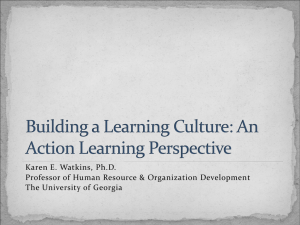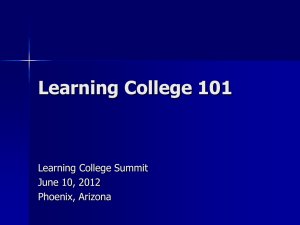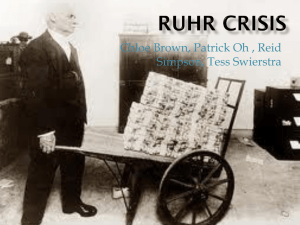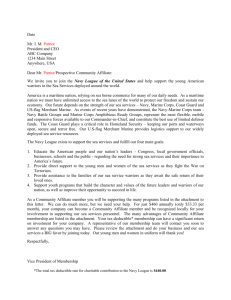WMY 2012 - Creating Goals - National Urban League Young
advertisement
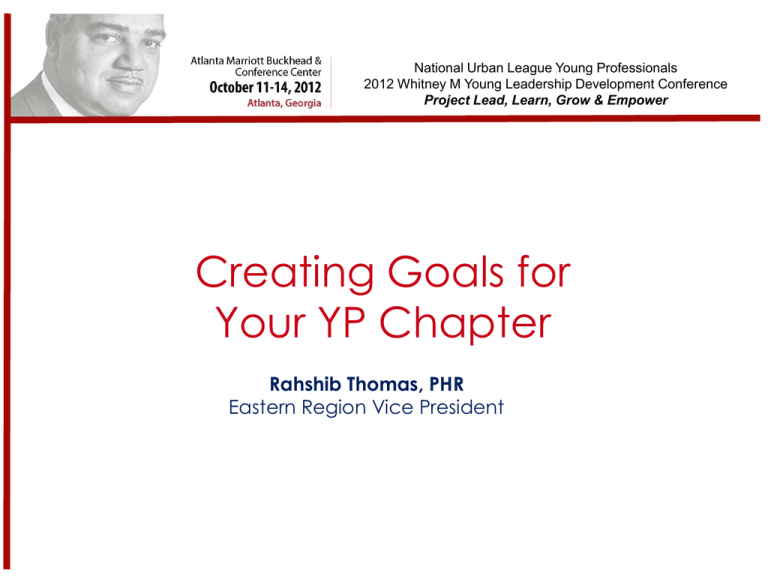
National Urban League Young Professionals 2012 Whitney M Young Leadership Development Conference Project Lead, Learn, Grow & Empower Creating Goals for Your YP Chapter Rahshib Thomas, PHR Eastern Region Vice President Desired Outcomes • Align with NUL Leadership Competency • Discuss what we know about goals • Discuss alignment with Affiliate, Regional & National • Discuss execution & motivation • Have Strategy Sidebars • Practice what we’ve discussed • Share inspiration Strategic View Competency Understanding the interaction between several complex components and the ability to look ahead consistently, to a longer time span of horizon. Having a shared vision with your Board, and then advancing your agenda in this complex environment. • • • Look beyond the day to day Think across borders Manage the interaction of funding cycle time, strategy, and resource requirements Strategic View Defined • Look beyond the day to day. Ensure you are looking up, past the day to day crisis management and are positioning the organization well in the community for a sustainable future. Evaluate progress against the strategic goals. Complete strategic planning aligned with National and local strategy. • Think across borders – to increase scale and coordination, CEO’s must think across their borders, regionally. • Manage the interaction of funding cycle time, strategy, and resource requirements – The ability to understand how the funding the CEO wants to pursue relates to the national and local strategy, the needs of the community, the timing of the program, and the resources required. (Note: this is beyond project management and into strategic planning). Let’s be Honest with Ourselves Stable, meaningful external affairs don't occur until we've experienced an internal stirring. -p.185 Failing to deal with internal issues effect many, if not all, areas of your life…especially executing goals. What do you get when you Google “Goal Setting?” Goal Setting 6 Goal Setting • S pecific • M easurable • A ttainable • R elevant/Realistic • T ime-targeted • Provide a sense of direction and purpose • Capitalize on our brain power to achieve • Convert strategy into targets Common Chapter Goals • Increase membership • Raise money • Increase volunteer hours • Increase member engagement • Become a better leader • Increase affiliate give What’s not SMART about these? Chapter leaders have the vision, Someone on your team may know how to make it SMART Past Goals Were they… • Motivating • Well-rounded • Not too easy, not too hard but attainable • An action statement • Part of a shared goal (i.e. Involved people, required buy-in and participation) • Help you grow internally (Did you include support from the affiliate/subject matter expert) At the Chapter Level • When do we set goals in YP Chapters? • How often do you check on your goals? • Who has access to your goals? • Where are your goals written down? Sidebar: Strategic Planning A process of defining strategy, direction, and making decisions on allocating its resources to pursue this strategy. Generally 1-3 or 3-5 years, deal with at least one of three key questions: • What do we do? • For whom do we do it? • How do we excel? The key components include an understanding of the organization's vision, mission, values and strategies. Common approach: • Situation - evaluate the current situation and how it came about. • Target - define goals and/or objectives (ideal state) • Path / Proposal - map a possible route to the goals/objectives Cascading: Aligning Goals • What organizational forces impact your chapter goal setting? • How do you manage? • What’s the benefit to aligning goals? Tip: Begin retreats with built in calendar items Start With Why Golden Circle • Motivation • Process • Product “WHY?” can correspond to an immediate goal, but to truly inspire volunteers, the “WHY should align with overall intent/purpose Leaders usually are good at the “WHY?” but your team may have the “HOW” Goals by Brian Tracy • Clarify your Values • Analyze your Beliefs • Determine Your True Goals • Improve your Family Life and Relationship • Optimize your Health and Wellness • Associate with the Right People • Manage Your Time • Review and Visualize your Goals Continually • Activate your Superconscious Mind 4 Disciplines of Execution Precise rules for translating strategy into action at all levels of an organization. When applied, produce extraordinary results by tapping the desire to win that exists in every individual. • Discipline of Focus • Discipline of Leverage • Discipline of Engagement • Discipline of Accountability What keeps you from executing your goals? Turning Goals Into Action • Obstacles -Doing lesser priorities first -Not being organized -Losing focus • Ways to make it happen – Task lists (Outlook//Smartphones//Google Tasks//Reminders) – Scheduled updates – that are reported on during monthly/quarterly one-on-ones with your chapter/CEO – Inspiration (Source) – Use your own personal source of inspiration to motivate you Activity- Make these SMART Instructions: Pick one, follow the chart below. You have 5 minutes Increase membership | Raise Money Increase volunteer hours |Increase member engagement Become a better leader | Increase affiliate give My goal is to… (Specific Measurable Attainable Relevant Timely) WHY? To achieve my goal, I’ll need to take the following actions… I’ll know that I’m successful when… (quantifiable measures) Sidebar: Dilemma Management Some complex problems simply do not have "solutions." The key to being an effective leader is being able to recognize and manage such problems. Polarity Management by Barry Johnson presents a unique model and set of principles that will challenge you to look at situations in new ways. + + High Focus Out of Focus Pole A Pole B - Out of Focus - High Focus National Urban League Young Professionals 2012 Whitney M Young Leadership Development Conference Project Lead, Learn, Grow & Empower Departing Thoughts People often say that motivation doesn’t last. Well, neither does bathing --- that’s why we recommend it daily. -Zig Ziglar Leaders should be just as intentional about providing emotional value to members as they are about providing rational value. Organizational health is the single most competitive advantage - Patrick Lencioni National Urban League Young Professionals 2012 Whitney M Young Leadership Development Conference Project Lead, Learn, Grow & Empower Questions National Urban League Young Professionals 2012 Whitney M Young Leadership Development Conference Project Lead, Learn, Grow & Empower




